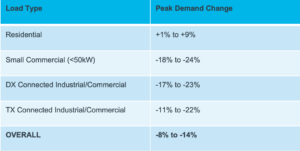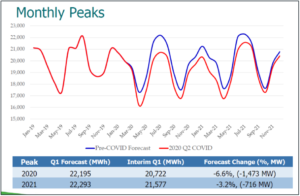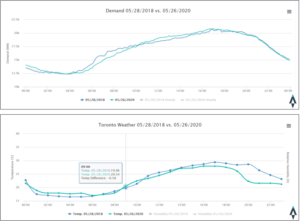The Impact of COVID-19 on Ontario Electricity Peaks
By: Workbench Energy
June 14, 2020
Initial evidence from this spring and early summer suggest that peak demands this year could reach or even exceed levels Ontario saw pre-COVID-19.
As those of us who are closely involved with the Ontario Industrial Conservation Initiative (ICI) know, May 1st marks the start of a baseline period where the process of identifying the top 5 peaks begins for all Class A customers.
This year’s baseline period started unlike any before because we were in the middle of the COVID-19 crisis, with large portions of the province under shutdown orders and many people working from home. Under these conditions, we were all left to wonder: “What will happen to the top 5 peaks this year?” Across the electricity sector, everyone was doing their best to analyze the data in real time to figure out that critical answer.
The IESO’s View of the Upcoming Peaks
For their part, the IESO shared their analysis of COVID-19’s impact and their forecast for how this would affect peaks this summer and beyond. First, the IESO analyzed how much each load type had been impacted by COVID-19. The table below sets out their conclusions:

The province, as a whole, was seeing an 8-14% drop in peak demand due to COVID-19. This equates to about 1,500 to 2500MW off the peaks. Although the overall amount was significant, load types were not impacted equally, with “Small Commercial” down the most, and “Residential” demand higher than normal.
With this observed impact in mind, the IESO provided an updated forecast for the expected peaks for the upcoming summer and winter. Their revised prediction is illustrated in the following chart:

This data suggests the IESO was expecting peaks to be nearly 1,500MW lower this summer than they would have been pre-COVID-19. Last year, Ontario’s #5 peak was about 21,400MW. Assuming a summer like the one we had last year, this year we would expect to see a top 5 peak in Ontario below 20,000MW.
At the time, our analysis was largely in line with the IESO’s, but we projected a more modest reduction to the upcoming peaks.
The Big Surprise
With broad agreement that peaks would be much lower than in years past, as a result of the effects of COVID-19, “Class A” customers were prepared with updated plans and strategies to respond to the highest of Ontario peak hours. But then came May 26, 2020 – proving forecasters wrong.
May 26, 2020, was a very hot day across most of Ontario. Temperatures approached record levels in many areas of the province. At the start of the day, the IESO’s forecasted peak demand was 19,600MW. By the end of the day, the actual peak had climbed to 20,600MW and everyone was left asking: “What happened to the lower peaks this year?”
As it turns out, May 26, 2020, was very similar to May 28, 2018. It is very interesting to compare the outcomes of these two days. The following two charts show the demand on May 26, 2020, vs. May 28, 2018, and also shows the temperatures in the GTA on each day:

Temperatures on May 28, 2018, were slightly warmer than this year on May 26, 2020. However, the demand in 2020 exceeded that of 2018. Additionally, the amount of ICI curtailment this year was significantly more than in 2018 since so many “Class A” customers were anticipating much lower peaks in 2020 vs. 2018. This means underlying demand was likely higher on a comparable basis.
So…What Happened?
Since May 26, 2020, we’ve seen additional hot days with temperatures at, or above, 30 degrees Celsius. In each case, demand in Ontario has approached levels in-line with what we would have seen in previous years. This has left many people wondering if businesses are still closed or at reduced capacity, where is the demand coming from?
While it is too soon to say for sure what is driving up demand on hot days this year, the most likely explanation is increased residential consumption due to more people staying home as they continue to self-isolate in efforts to “flatten the curve”.
Unlike large commercial and industrial businesses, air conditioning is a meaningful percentage of home electricity consumption on hot days. That is why residential loads are sometimes called “weather sensitive” – their consumption tracks closely with the temperature outside. Before the very hot weather, all the data available on COVID-19’s impact on demand was during a period of mild weather (in the earlier winter months when the pandemic started). This was when there was not a lot of heating or cooling systems using electricity. While residential load may have increased by only 1-9% on mild days, it seems likely the increase is significantly more on very hot days when the air conditioners are switched on and running at full capacity. And the reduction from the large commercial and industrial customers is likely stable since they are not as closely tied to the weather.
What About the Industrial Conservation Initiative (ICI)?
Heading into the current peak season, most forecasters expected the amount of ICI megawatts responding on a peak day to be less this year than previous years because a number of businesses are already at a reduced demand level and therefore cannot reduce by as much as they have in the past.
While this is true for a number of businesses, others are responding with more megawatts than in the past as they make lemonade out of a lemon and take advantage of low production levels to increase their response to peak events and earn lower power costs for the flexibility they are providing.
What Does it All Mean?
Initial evidence from this spring and early summer suggests that peak demands this year could reach or even exceed levels Ontario saw pre-COVID-19. While most forecasters still expect a peak reduction over the summer months, most would agree that it will be much less significant than originally thought. As discussed above, recent data points indicate there is now the possibility of COVID-19 increasing the Ontario peaks over the coming months.
For Class A customers, this means they should expect to see a peak season this year which is much more similar to past years than many were initially expecting.
About Workbench Energy
Workbench Energy is a technology company and service provider for large power consumers and other participants in the IESO energy markets and programs. The company’s peak advisory service, NRG Peaks, is Ontario’s premier service providing customers with advanced intelligence, cloud-based software and expert advice. Learn more at workbenchenergy.com



